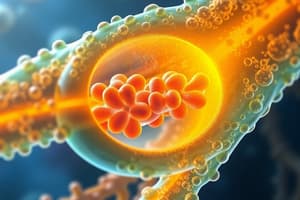Podcast
Questions and Answers
What is the defining characteristic of simple diffusion?
What is the defining characteristic of simple diffusion?
- It relies on specific carrier proteins for transport.
- It allows small, nonpolar molecules to pass directly through the membrane. (correct)
- It requires energy input from the cell.
- It moves molecules against the concentration gradient.
Which type of membrane transport mechanism requires the assistance of proteins embedded in the cell membrane?
Which type of membrane transport mechanism requires the assistance of proteins embedded in the cell membrane?
- Osmosis
- Facilitated diffusion (correct)
- Active transport
- Simple diffusion
What type of molecules primarily undergo simple diffusion across the cell membrane?
What type of molecules primarily undergo simple diffusion across the cell membrane?
- Complex carbohydrates
- Small nonpolar molecules (correct)
- Large polar molecules
- Ionic compounds
Which of the following statements about passive transport mechanisms is true?
Which of the following statements about passive transport mechanisms is true?
What is the primary purpose of membrane transport mechanisms in cells?
What is the primary purpose of membrane transport mechanisms in cells?
What characterizes gated channel proteins?
What characterizes gated channel proteins?
Which process requires energy input to move molecules against their concentration gradient?
Which process requires energy input to move molecules against their concentration gradient?
What is the primary role of carrier proteins?
What is the primary role of carrier proteins?
Which of the following is a key characteristic of primary active transport?
Which of the following is a key characteristic of primary active transport?
What is an example of osmosis?
What is an example of osmosis?
Study Notes
Membrane Transport Mechanisms
- Cells require food, salts, water, and oxygen for effective functioning while eliminating waste like carbon dioxide.
- Membrane transport regulates the movement of solutes (ions and small molecules) through biological membranes.
- Factors influencing transport include membrane permeability, solute concentration, size, and charge of solutes.
- Four primary types of membrane transport mechanisms: simple diffusion, facilitated diffusion, osmosis, and active transport.
Simple Diffusion
- Movement from high to low concentration, following the concentration gradient.
- Allows small, nonpolar molecules (e.g., oxygen, carbon dioxide, water) to pass through membranes without transport proteins.
- Achieves equilibrium where concentration is equal inside and outside the cell.
- Example: Oxygen diffuses from lungs into blood; carbon dioxide diffuses from blood to lungs.
Facilitated Diffusion
- Molecules move from high to low concentration with the help of carrier or channel proteins.
- Important for water-soluble molecules unable to traverse the phospholipid bilayer independently.
- Channel Proteins: Create pores in the membrane for charged molecules; can be open (continuous passage) or gated (regulated movement).
- Carrier Proteins: Bind to specific molecules, change shape, and release them on the other side; functionality depends on temperature and saturation.
Osmosis
- Movement of water through a semipermeable membrane from lower to higher solute concentration.
- Membrane allows water but restricts larger solutes (e.g., sugar, salt).
- Examples: Thirst after salty food consumption; raisins and seeds swell when soaked in water; kidney dialysis.
Active Transport
- Movement against the concentration gradient from low to high concentration, requiring energy (typically ATP).
- Essential for maintaining concentration differences across membranes.
- Types of Active Transport:
- Primary Active Transport: Directly utilizes ATP for movement; e.g., sodium-potassium pump transports sodium out and potassium into the cell.
- Secondary Active Transport: Uses electrochemical energy from ion movement down their gradient to move another molecule against its gradient.
- Examples:
- Phagocytosis (macrophages engulfing bacteria).
- Calcium ion transport from cardiac muscle cells.
- Amino acid transport across the intestinal lining.
- Protein secretion (enzymes, hormones, antibodies).
- Immune response (white blood cells attacking pathogens).
Summary
- Membrane transport mechanisms—simple diffusion, facilitated diffusion, osmosis, and active transport—are crucial for cellular homeostasis, ensuring nutrient uptake and waste removal.
Studying That Suits You
Use AI to generate personalized quizzes and flashcards to suit your learning preferences.
Description
Explore the various mechanisms involved in membrane transport that allow cells to intake essential substances and eliminate waste. This quiz will cover concepts like membrane permeability and the movement of solutes. Test your understanding of how these processes contribute to cellular function.




